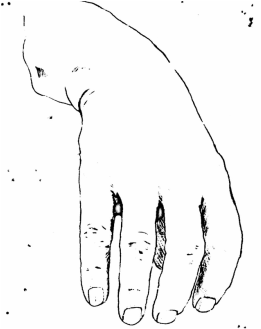 Keep the natural shape
Keep the natural shape The key component of this new way of interacting with the bow is to keep the natural shape of your hand--and keeping the natural shape can be easier said than done! When your hand is relaxed, the bow feels as though it might fall--and our natural reaction is to grab at it.
We have to learn to let go!
There are two basic guideposts to help you achieve this easy bow hold:
1) The ZOMBIE drape
2) SIDEWAYS thumb
Zombify your fingers!
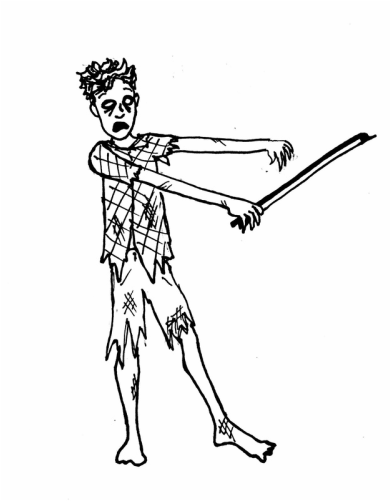 AAAAAAArgh....No paaaaaaaaaains!
AAAAAAArgh....No paaaaaaaaaains! Cultivating a zombie finger drape is easy:
With your bow stick held in your LEFT hand, stretch both arms out in front of you with the hands dangling from the end of your straight arms and wrists (like a zombie).
Deactivate every muscle in your right hand so it feels completely dead. Shake it out and try again if you feel any tension in the hand.
Once you have a "dead" hand, bring your hands/arms together so that the fingers of your right hand fall in front of the bow's frog like a curtain.
For now, let your thumb hang out behind the bow without touching it. We'll deal with him in the next section.
The spacing of the fingers can be confusing, so I found a video that I really like that can help guide you in this process: https://www.youtube.com/watch?v=xNgo_wjhlo4
Thumb moves sideways
Now to the real troublemaker of the bow hand: the thumb. That guy was the reason my hand felt so bad when I was a youngster. To understand the power that your thumb has to make your life miserable, I will walk you through a little demonstration that blew my mind when Martha did it for me.
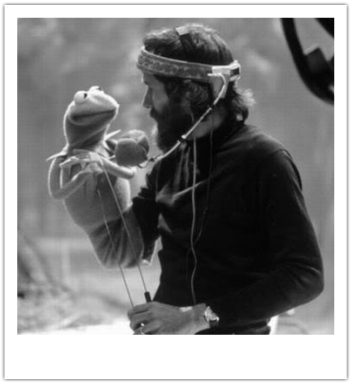 Oh, Kermie!
Oh, Kermie! Now turn your hand upside down and use your left hand to touch the muscle at the base of your palm (that connects to your thumb). Feel how tense it is?
Okay, good. Now, that's what you DON'T want in a bow hand (as much as I love Kermit, he's just no good for the cello bow... although we do hold the "frog." Hmmm).
Now take the bow away and revert to the "zombie" hand for a moment--just let everything go dead. Observe the natural attitude of the thumb.
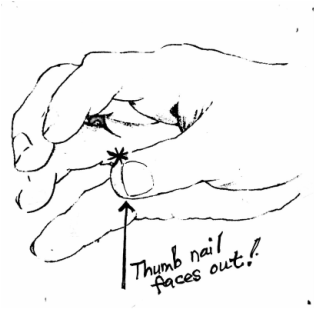 Sideways thumb
Sideways thumb Now drape the zombie fingers on the front of the bow and swing the thumb sideways back and forth freely (like Tarzan!) until it finds the part of the frog that attaches to the stick. Let the back of your thumb rest lightly against that bump of the frog. In this position, the top corner of the thumb (the * in the picture to the right) will lightly touch the stick of the bow at the convergence of the frog and the stick.
Balance the bow between your zombie fingers in front and the inactive, sideways-facing thumb behind and turn your hand upside down again. Use the left hand to feel the tension level of that thumb muscle.
It should be smooshy feeling, not hard and flexed.
That is the difference that blew my mind (and still does to this day). It's physically comfortable and easy to hold the bow this way!
| So why do we try to hold the bow ther other way, pinching it with the thumb and fingers? WHY?! It hurts! Why would we want to hurt ourselves?! (This is a massive question that extends way beyond the boundaries of this little cello blog, so for now we will just let that hang there and ponder it as we navigate our lives.) Whatever the answer is, I think part of the reason we don't naturally use the thumb in this sideways manner is that it is pychologically hard because it feels as though you will drop the bow. A sideways thumb is too easy. We naturally desire control, so we desperately grab the bow to protect it from the force of gravity. |
Stay tuned!

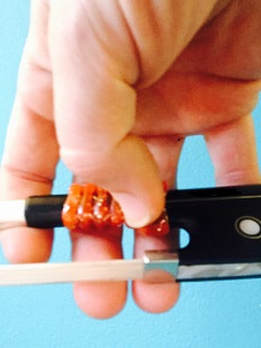
 RSS Feed
RSS Feed